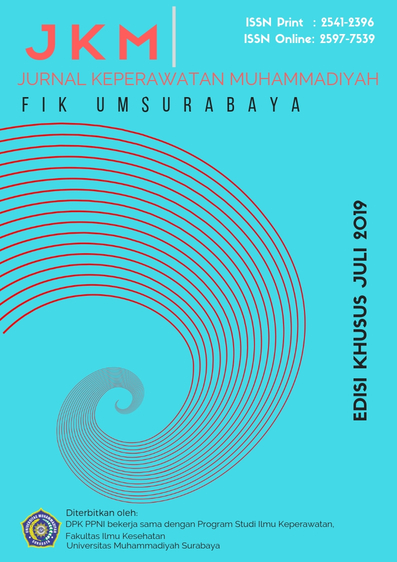Faktor Risiko Terjadinya Manifestasi TB Paru Pada Penderita DM Tipe 2 Dengan Tes Mantoux Positif
DOI:
https://doi.org/10.30651/jkm.v4i2.2527Kata Kunci:
DM, education, BMI, DM control practice, lung TB occuranceAbstrak
Background: DM disease has a high risk to progress from latent TB to be active TB because of immune cell function defect. A few researches proved the use of prophylaxis therapy for latent TB infection for the patients with positive mantoux test. In Indonesia INH prophylaxis treatment with control management of the risk factor to the occurance of lung TB for type 2 DM patients with positive mantoux test needed to be paid attention to prevent getting TB. A long term prophylaxis treatment needed to be considered because of hepatotoxicity risk.
Method: The research was case control study, the research was done from May to July 2017 at RSUD Dr. Soetomo and one of private hospitals in Surabaya. The number of sample was 60 respondents who consisted of case and control groups using consecutive sampling technique. The data collection used interviews and mantoux test practice. The statistics test used chi-square test.
Result: Type 2 DM patients with positive mantoux test without manisfestation of TB lung 10 (33,3%) male and 20 (66,7%) female. Chi square test result shared that there was a correlation between BMI and DM control practice for type 2 DM patients with the occurrence of lung TB. Logistic regression test result showed that education (p=0,023 OR=5,897), BMI (p=0,004 OR=10,197) and DM control practice (p=0,003 OR=7,997) for type 2 DM patients who has the risk of lung TB occurance.
Conclusion: The dominant factor of education, BMI and DM control practice that was influential to the occurance of lung TB was BMI.
Referensi
Perkumpulan Endokrinologi Indonesia. 2015. Konsensus pengelolaan dan pencegahan diabetes melitus tipe 2 di Indonesia. Jakarta: PB PERKENI.
Yamashiro S, K, Uezu K, Kinjo T, Miyagi K, Nakamura K. 2005. Lower expression of Th1-related cytokines and inducible nitric oxide synthase in mice with streptozotocin-induced diabetes mellitus infected with mycobacterium tuberculosis. Clin Exp Immunol. 139: 57-64.
Knechel,N.2009.Tuberculosis:Pathophysiology, Clinical features and diagnosis. Critical Care Nurse. 29 (2). pp. 34-43
Menzies, D. Hamdan, AI. Badriah Al Otaibi. 2011. Recent developments in treatment of latent tuberculosis infection. Indian Journal of Medical research. 133(3): 257-266
WHO. 2015. Treatment of tuberculosis: guidelines. 4th ed. Geneva: WHO Press
Alisjahbana B, van Crevel R, Sahiratmadja E, den Heijer M, Maya A, Istriana E, et al. 2006. Diabetes Mellitus is strongly associated with Tuberculosis in Indonesia. Int J Tuberc Lung Dis.10: 696-70.
Wulandari DR, Sugiri YJ. 2013. Diabetes melitus dan permasalahannya pada infeksi tuberkulosis. J Respir Indon. 33(2): 126-34.
Wen CP. 2013. The reduction of Tuberculosis risks by smoking cessation. BMC Infectious Diseases. 10: 156.
Baghaei P, Marjani M, Javanmard P, Tabarsi P, Masjedi MR. 2013. Diabetes mellitus and tuberculosis fact and controversies. Journal of Doabetes & Metabolic Disorder. 12: 58-66.
Broxmeyer L. 2005. Diabetes mellitus, tuberculosis and the mycobacteria: Two millennia of enigma. J Mehy. 5;2-6.
Wijayanto, A. Erlina B, Arifin N, Rochsismandoko. 2015. Faktor Terjadinya Tuberkulosis Paru pada Pasien Diabetes Mellitus Tipe 2. J Respir Indo Vol. 35
Towhidi M, Azarian A, Asnaashari A. 2008. Pulmonary tuberculosis in the elderly. Tanaffos. 7(1):52-7.
Suastika K, Dwipayana P, Budhiarta AA, Syrabefara DN, Aryana IGPS, Saraswati IMR, Gotera W. 2004. Epidemiology Study of Metabolic Syndrome in Rural Population in Bali. International Journal of Obesity. 28: s55.
Budiman, A. R (2013). Kapita selekta kuisoner: Pengetahuan dan Sikap dalam Penelitian Kesehatan. Jakarta: Salemba Medika.
Restrepo BI, Fisher-Hoch SP, Crespo JG, Whitney E, Perez A, Smith B, et al. 2007. Type 2 diabetes and tuberculosis in a dynamic bi-national border population. Epidemiol Infect. 135: 483
Ezung T, Devi NT, Singh NT, Singh. 2002. TB. Pulmonary Tuberculosis and Diabetes Mellitus – a study. J Indian Med Assoc. 100(6):376-9.
Amin Z, Bahar A. 2006. Tuberkulosis paru Buku Ajar Ilmu Penyakit Dalam.Jilid II. Edisi ke-4. Jakarta: Pusat Penerbitan Departemen Ilmu Penyakit Dalam Fakultas Kedokteran UI.
Zhao W, Shi L, Fonseca, He J, Shao D, Zhao J, Chen QM, Yin A. Screening patients with type 2 Diabetes for active Tuberculosis in communities of China. Diabetes care. 2013; 36: e159-60.
Guptan. A, Shah A. 2000. Tuberculosis and diabetes: An appraisal. Ind. J. Tub. 47(3): 2-7.
Leung CC, Lam TH, Chan WM, Yew WW, Ho KS, Leong GM, et al. 2008. Diabetic control and risk of tuberculosis: A cohort study. Am J Epidemiol. 167: 1486-94.
Bates MN, Khalakdina A, Pai M. Risk of Tuberculosis from exposure to tobacco smoke: a systematic review and meta-analysis. Archives of Internal Medicine. 2007;167: 335-42. 14.
Kemenkes RI. 2015. Pedoman Panduan Pengelolaan TB-DM di fasilitas kesehatan Tingkat Pertama (FKTP).
Slama K, Chiang C-Y, Enarson DA. Tobacco and Tuberculosis: A qualitative systematic review and meta-analysis. International Journal of Tuber culosis and Lung Disease. 2007;11(10):1049–61.
Unduhan
Diterbitkan
Terbitan
Bagian
Lisensi
- Penulis tetap memegang hak atas karyanya dan memberikan hak publikasi pertama kepada jurnal ini yang secara simultan karya tersebut dilisensikan di bawah:Â Creative Commons Attribution-ShareAlike 4.0 International (CC BY-SA 4.0)













